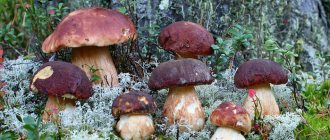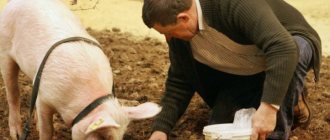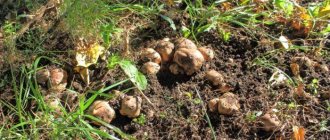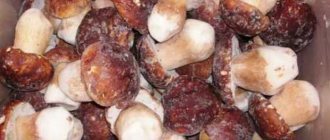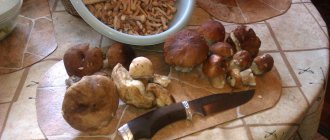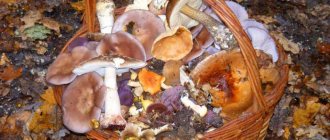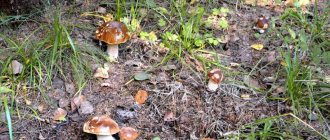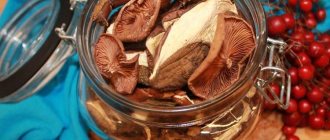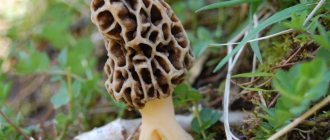Every summer, amateur mushroom pickers from Moscow begin to frantically scour the Internet in search of a map of mushroom places. Preferably, a map constructed as in novels about pirate treasures: “Get off at the 31st kilometer station, walk five hundred meters to the left to a gas station, then a kilometer due north, 70 steps to the west, and under a large pine tree you will find three hundred white ones.”
Unfortunately, finding a mushroom treasure map is extremely difficult. Firstly, for a serious harvest, as a rule, you need to go not to the 31st kilometer, but further away. Secondly, mushroom pickers who know good places won’t talk about them left and right. Thirdly, the general definitions that journalists love so much (such as “a lot of mushrooms in the Serpukhov area” or “in the Dubna area”) are meaningless. Yes, specifically the surroundings of Serpukhov or Dubna are mushroom places. But these are tens of square kilometers of forest. Try it, poke around with it - considering that the average Muscovite mushroom picker, as a rule, only has a few hours left.
What to do? Still, there are a couple of ways to find the “mushroom Klondike”. They are shared by KP columnist .
Conditions for mushrooms
All mushroom places rest on a kind of “three pillars”, which are the three main conditions necessary for the full existence of mushrooms:
- Warm. The more it is, the more intense the processes in the mycelium occur, and therefore, the greater the chances that a fruiting body will sooner or later appear on the surface of the earth. What's interesting is that different types of mushrooms require different amounts of heat. There are frankly heat-loving species, and there are also those that, on the contrary, grow well in cool conditions (for example, greenfinch or winter honey fungus, which manages to bear fruit in winter). At the same time, excess heat is also undesirable - with it, the mycelium can stop development. However, most of the collected mushrooms belong to heat-loving species, and therefore release fruiting bodies in the summer. It has also been noted that cold summers negatively affect the yield of these mushrooms.
- Humidity. Water is necessary for all living things on Earth, and mushrooms are no exception. Again, the speed of processes in the mycelium depends on how saturated the substrate is with moisture. When dry, it will go into suspended animation and certainly will not bear fruit. However, even here the mushrooms exhibit some selectivity. There are moisture-loving species that gravitate towards damp places (for example, some types of mushrooms), and there are vice versa - lovers of more or less dry soil (ceps).
- Symbiont plant. During evolution, many fungi have entered into a special, mutually beneficial alliance with higher plants. Its essence is that the mycelium entangles the roots of trees, thanks to which the latter receive water and minerals (especially phosphorus) in exhaustive quantities, while the fungus is content with little - some organic substances in finished form. Scientists call this mycorrhiza . In fact, all forest (coniferous and deciduous) trees, as well as some shrubs and shrubs, are symbionts of mycorrhizal fungi. Thanks to this union, both “partners” grow together much better in poor soil than individually. And it has already reached the point that some mushrooms almost cannot exist without trees, and some of them have even developed “loyalty” to specific species, while others “don’t want to know anything at all.” On the other hand, there are some mushrooms that can easily do without this symbiosis. They either “feed” on decaying organic matter (the same wood dust), or they are openly parasitic on plants.
It would be possible to add soil composition to the above conditions, but for most forest mushrooms it is not particularly critical. And in general, in any forest land there will be almost all the necessary substances for them. However, some mushrooms prefer soils that are particularly rich in organic matter, such as champignons and dung beetles. I will write more about mushroom soils below - in the section “Where mushrooms grow.”
So, these same “three mushroom whales” are very dependent on the type of landscape, topography and seasonal weather. These factors are also worth considering in more detail, and at the same time their influence on each other. Let's start with the first of them - landscape.
Boletus
Boletus or Boletus is the internationally recognized “king” of mushrooms. Many peoples have legends dedicated to it, in which the boletus appears to be the progenitor of all other mushrooms, both edible and poisonous. There are legends in which two boletus brothers appear. One of them gave the forests edible mushrooms. And from the mycelium of the second one, poisonous ones multiplied.
Today it leads the rare species of mushrooms and it is almost impossible to find any of its species, with the exception of white ones.
Boletus mushrooms can be not only edible; for example, some representatives of this forest family are poisonous:
- Satanic;
- beautiful or beautiful;
- legal or lawyer, almost never grew up here, but was often encountered in France;
- le kele;
- stocky;
- purple;
- porosporous;
- red-legged, similar to beautiful, but differs in bright red or orange “limb”.
It is very easy to distinguish inedible boletus species; they most accurately correspond to their popular names. However, finding them in our time is no less difficult than edible varieties of boletus.
Externally, edible boletus mushrooms are similar to porcini mushrooms, but they are more substantial and solid. If these two mushrooms are placed side by side, the difference between them will be the same as between a peasant woman and a queen, a mongrel and a Molossian Great Dane.
As for culinary features, there are none. Boletus is suitable for preparing any dishes, can be prepared in all ways and has no equal in nutritional value.
Mushroom landscapes
Over the entire history of the development of the Earth, mushrooms have adapted quite well to various types of terrain, which is why they can be found not only in the forest, but also in the tundra, and even in the steppe. They also grow in swamps and on the surface of lake rafts. First, let's look at the forest area, since the lion's share of mushrooms collected by humans grows there.
Mushroom forests
In terms of heat and humidity, all forests, regardless of the tree species growing in them, can be divided into three categories of mushroom places:
small forest
Such forests arise in old clearings or in open spaces that have been withdrawn from agricultural use. The main condition is a forested area and mature trees located nearby, the seeds from which quickly sow the former field, and after a few years a low growth of young trees appears on it.
Artificial forest plantations can also be classified as small forests. You can distinguish them from self-seeding ones by the way the seedlings are located. In artificial plantings they stand less frequently, are almost the same height and are usually ordered, but in natural plantings, as a rule, all the trees stand close to each other and their height varies. Well, of course, there is no order in the arrangement of trees, but complete chaos reigns.
Typically, small forests are young self-sown pine forests, birch forests, aspen forests, or a mixture of various species. Their age is no more than 10 years, the height of the trees has not yet reached its usual value for real forests, and the undergrowth as such has not yet developed. As a rule, such forests are well heated by the sun and evaporate moisture no less well. Therefore, in flat areas there is plenty of heat, but there is usually a minimum of moisture in the soil, which, however, does not prevent small forests from being normal mushroom places under favorable weather conditions.
Open Woods
Overgrown small forests, or forests where the density of trees is relatively low. The undergrowth can be sparse or dense. Examples of such forests are tall, fairly sunlit birch or aspen forests.
The warmth and humidity of the soil here are kept at approximately average levels. These forests are quite successful as mushroom places.
Taiga
Spruce or fir, or mixed. And in general any forest where the tree density is high. Only a minimal portion of the sun's rays reaches the earth's surface here. Therefore, twilight and coolness reign in such forests, and soil moisture reaches maximum values for the forest. The taiga is quite a mushroom place, but special “taiga” species of mushrooms grow here.
Sometimes it happens that a swamp intersects with the taiga and an urman - another type of landscape characterized by high humidity, and another very good mushroom place. Such forests are less dependent on precipitation, and therefore more promising for mushrooms in dry years.
Summarizing all of the above about different forests, we can say with confidence that the most promising mushroom areas are forests of the second type. And indeed, it was here that the yields of mushrooms (especially white mushrooms) were always high.
Open spaces
This can include all those types of landscapes that do not have trees or have them in minute quantities. There is an abundance of solar heat here, but with moisture it can be different.
- Moss swamps or lake rafts . The wettest and most mushroomy places among all open spaces. All that is required for mushrooms is just the sun's heat. In terms of symbiont plants, as a rule, there is no shortage, because swamp soil is usually penetrated by the roots of various tree-like shrubs, ranging from small heathers (cranberries, blueberries, crowberries, etc.) and ending with fully established trees, such as small birches, pine trees and others.
- Tundra. There is a slight change in moisture here. However, this in no way prevents this type of landscape from being an excellent mushroom place. Including thanks to the symbiont trees that grow here in a dwarf form.
- Dry open spaces, steppes . Mushroom places appear only in favorable seasons - when sufficient rainfall falls from the skies.
It is quite obvious that the first two areas are very tempting for mushroom pickers.
Relief and mushrooms
The height and slope of the earth's surface also influence whether a particular area can be classified as a mushroom area.
| Terrain type | Moisture | Warm |
| Lowlands (including places near water bodies) | A lot of | Average |
| Heights | Few | Average |
| North side of the mountain | A lot of | Few |
| East and west sides of the mountain | Average | Average |
| South side of the mountain | Few | A lot of |
That’s right - the most mushroom places are usually the lowlands. There are usually more mushrooms growing there than in mountainous areas. Near bodies of water, heavy dew falls in the morning - this has a beneficial effect on soil moisture.
Mushroom weather
Summer can be different. Sometimes it’s normal - when there are a lot of sunny days and heavy rainfall periodically (the most mushroom weather). And sometimes it’s cold and rainy. And it also happens that for the entire July-August - not a drop from the sky. But the heat is abnormal and naturally “dries out” everything, even the grass burns out. And once I observed a generally “unique” summer, when there didn’t seem to be much rain, but the weather was cloudy and cool all the way.
The yield of mushroom areas also greatly depends on what the season will be like. In this regard, four types of summer can be distinguished:
| Summer | Warm | Moisture | Productivity of mushroom places |
| Cold dry | Few | Few | Extremely bad. |
| Cold wet (rainy) | Few | A lot of | Mushrooms appear, but with a delay. As a rule, in such summers there are a lot of wormy mushrooms, but their overall yield leaves much to be desired. But it also happens that in the fall nature “takes revenge” with autumn species that are unpretentious to heat. |
| Warm dry (arid) | A lot of | Few | Everything in the forest is perfectly dry. There are no mushrooms during the summer. They appear only in the fall - when it starts to rain. But the productivity of the mushroom place at this moment reaches its possible peak, which cannot but rejoice. |
| Warm wet (normal) | A lot of | A lot of | Best mushroom weather. Usually in such summers there are tons of mushrooms everywhere. |
Manifestation of weather in different mushroom places
Now comes the most interesting part. It’s not for nothing that I listed above different types of mushroom places that differ in landscape and topography. As the practice of mushroom picking shows, in different seasonal weather they manifest themselves completely differently. And here we get a rather funny sign:
| Mushroom places | Summer | |||
| Cold dry | Cold wet | Warm dry | Warm wet | |
| Forests | No or few mushrooms | Closer to autumn, not particularly heat-loving species of mushrooms, such as saffron milk caps or milk mushrooms, appear. If the summer is not very cold, the area may please you with some boletus harvest. | No or few mushrooms | Usually in such years there are plenty of mushrooms in a given area. |
| Moss swamps, rafting grounds | The lack of heat only affects the timing of the appearance of heat-loving mushrooms. There is always enough moisture here, so there will be mushrooms even in cold summers, but not in such quantities as in warm ones. | These types of terrain are independent of precipitation, therefore there will be a lot of mushrooms here in both cases of warm summer. | ||
| Places near bodies of water | There is moisture, but with heat things are worse. Nevertheless, you can count on some mushroom harvest | Heavy dew in the morning moisturizes the soil well. As a result, it is along the banks of reservoirs that mushroom picking can be very successful in dry summers | There is plenty of moisture and heat - the mushroom harvest will be maximum | |
| Southern slopes of forested mountains | No or few mushrooms | These places are well heated by the sun, as they are oriented to it at a steeper angle. During the cold but wet summer, the best mushroom harvest occurs here. | No or few mushrooms | In this weather there are usually plenty of mushrooms |
| Northern slopes of forested mountains | No or few mushrooms | You can count on a small harvest of mushrooms that are not very demanding of heat | There are no or few mushrooms, but in some cases it is on the northern side of the mountain that in dry summers you can count on some mushroom harvest | There is more shade here, and therefore noticeably colder. There are mushrooms, but there are slightly fewer of them than in warmer places |
| Open spaces | No or few mushrooms | The usual crop of mushrooms such as umbrellas and champignons appears | ||
Another very funny moment here is connected with the time of year, or more precisely with autumn, or with how quickly mushrooms disappear with the first cold weather. As it turned out, nature has its own reservoirs of heat, which can somewhat “stretch” the mushroom season in time. These are swamps, as well as large bodies of water. It has been noticed that mushrooms can be picked near them even in October, and sometimes even from under the snow.
Which ones are edible?
The most common edible mushrooms in the forests of the middle zone are:
- boletus;
- boletus;
- boletus;
- white;
- milk mushrooms (white and black);
- volnushki (svinushki);
- flywheels;
- boletus;
- saffron milk caps;
- chanterelles;
- valui (calves);
- Russula.
In addition to them, in recent decades they have begun to actively collect champignons, both forest and field, which traditionally in Rus' were not brought home in baskets, just as white ones were not taken in Switzerland from time immemorial.
Of course, the types of edible mushrooms are not limited to this list. However, it is these forest creatures that most often end up in baskets.
Where do mushrooms grow?
Forests are forests, fields are fields, weather is weather, but do not forget that the nature of the soil also affects whether a place is mushroom or not.
Forest litter rich in organic matter is the best soil for mushrooms. However, litter differs from litter. It not only turns out to be diverse in itself, but can also retain moisture important for mushrooms in different ways. And well-rotating soil is also a source of heat, because as is known, the rotting of any organic residue releases it in sufficient quantities (remember the “smoking” piles of manure or sawdust in collective gardens).
Fallen needles
Its top layer is blown quite well, so most often it is dry. In terms of nutrients - so-so. The rotted needles are located deeper - that’s where things with moisture and nutrients are much better. This is where the bacteria have worked hard, and this is where the fungal mycelium is usually located. The most common mushrooms found on fallen pine needles are russula and other milk mushrooms, but there are also porcini mushrooms, moss mushrooms, etc.
fallen leaves
It retains moisture better than the previous point, and - apparently - richer in nutrients. There are noticeably more mushrooms here; moreover, their “assortment” is clearly more diverse.
Well, of course, such litter does not appear on its own, but accompanies deciduous trees, all of which are symbionts for mycorrhizal fungi. Such as whites, obabki, milk mushrooms and others.
Moss areas
It has been noticed that where moss (sphagnum moss or something else) has grown on the ground, mushrooms appear many times more readily than on ordinary soil. This can be clearly observed when collecting saffron milk caps, especially in small forests. This is explained quite simply: moss, being a lower plant, and therefore moisture-loving, itself tries to take care of preserving water in the place where it grows. His jackets are organized like dense pillows, well permeable to water from above, but, alas, not particularly permeable to water back. In addition, moss is a good heat insulator - it’s not for nothing that in the old days they put it between logs in log houses, or even covered the roof with it.
From this we can also conclude that moss is one of the external signs of mushroom places.
Grass
This means “a natural version of the lawn.” Mushrooms also grow in such well-developed grass, but they don’t particularly like it. Perhaps because of the dense turf, through which throwing out fruiting bodies is a complete hassle. Or maybe the grass somehow competes with the mushrooms, “taking away” moisture, nutrients or space from them? But this is not so important. The main thing is that when picking mushrooms you always notice that they are rarely found in dense grass, with the possible exception of umbrellas and champignons. But if the grass is sparse, mushrooms are often found in it.
However, if the grass does not grow haphazardly, but in occasional clumps, you should know that this is a clear sign of a mushroom area, and in addition to everything, it is one of the signs of porcini mushrooms.
Dense forbs, weeds
As a rule, this vegetation occurs in old wastelands or in low-lying meadows that are well-fed with water. Sometimes there are such thickets that even walking through them can be difficult. But they retain moisture very well - even the dew at the very roots does not evaporate during the whole day. For mushrooms, this is the promised land. Only here there are all kinds of toadstools growing here, or species that are not usually collected in our area (all sorts of umbrellas, meadow mushrooms, etc.). It turns out that this type of landscape is not included in mushroom areas.
How to avoid getting poisoned and what to do if you're unlucky
Mushroom poisoning can indeed be dangerous and lead to death, states Kurakov. Food poisoning is accompanied by nausea, vomiting, diarrhea, pain in the stomach and intestines, and possible fever.
Depending on the toxin, the first signs of poisoning may not appear immediately. “When consuming toadstool, the first symptoms appear within six hours. During this time, the toxin has already entered the bloodstream and spread throughout the body. It affects the liver, kidneys, and nervous system. And you can hardly remove it. This situation is difficult to treat,” Kurakov said.
Pale toadstool is generally the most dangerous mushroom. It contains two toxic substances: phallin and amanitin. Acting on the human body in a “shock tandem”, they can easily lead to death. The likelihood of an unfavorable outcome for children is especially high.
There are mushrooms that cause a toxic effect quickly enough, and then a person can be saved. There are toxins that are not fatal, but cause intestinal poisoning. In the forest, you can easily run into hallucinogenic specimens, for example, among fly agaric mushrooms.
If you suspect that you have been poisoned by mushrooms, do not take risks and call an ambulance, your life may depend on it.
Collected mushrooms cannot be stored for a long time. If there are so many of them that you haven’t prepared all of them, it’s best to freeze the rest. The second most effective storage method is to dry. If this is possible, of course, because not everything can be dried. You can’t - milk mushrooms, mushrooms, saffron milk caps. Store boletus, boletus, chanterelle, and boletus either frozen or dried. Then they retain maximum nutrients.
And if you pickle or salt, the mushrooms must be perfectly clean. This is not a quirk of perfectionists. If soil particles remain, clostridia may appear - anaerobic toxin-producing bacteria. They produce dangerous deadly poisons. These bacteria cannot be removed by prolonged boiling. It happens that all the mushrooms in the jar are edible, but if soil gets in, you can be poisoned not by the mushrooms, but by the poison of the bacteria.
What to do in case of mushroom poisoning
In case of poisoning, doctors urge you to follow the instructions below:
- Empty your stomach and intestines as quickly as possible. To do this, induce vomiting and rinse the stomach with boiled water at room temperature. Under no circumstances should you wash your stomach with potassium permanganate!
- Take activated charcoal. At the rate of one tablet for every 10 kilograms of your weight every 2-3 hours. Take until charcoal appears in the stool;
- Wrap up and stay warm;
- Drink warm water in large quantities;
- You cannot eat until toxins are completely eliminated from the body.
Where to pick mushrooms
Photo 2. The outskirts of small forests consisting of self-seeding young pine trees. In a warm, rain-rich season, such a forest produces a good harvest of buttermilk in the summer and an equally good harvest of saffron milk caps in the fall.
Now is the time to talk about tactics for finding mushroom places. This tactic most often has to be used in forests, because this is the most “difficult” landscape in terms of gathering. In other places where mushrooms grow, the search is greatly simplified.
The first thing a forest collector should pay attention to is the local (shallow) topography, as well as the density of trees. At small elevations such as hillocks, hillocks and “ridges”, the average temperature is always slightly higher than in the lowlands. Clearings, “windows,” or places where trees grow less densely or are filled with young growth are more open to the sun, and therefore also warm up better than the rest of the forest. It is here, on the hills and shallow clearings, that you most often come across “witch circles” and other mushroom accumulations.
Photo 3. A typical mushroom place: a loose birch forest with a well-developed rowan undergrowth, with moss areas and a thin grass cover consisting of meadow grasses and stones, as well as with small differences in relief (hills, hollows) and clearings. A river flows a few meters from this place. Types of mushrooms growing in such a forest: chanterelle, milk mushroom, honey fungus, boletus, porcini mushroom.
If there are large clearings in the forest overgrown with grass, then the mushrooms are concentrated along their edges, especially along the northern edges. The same is observed in clearings. If the latter are oriented from south to north, then the mushrooms simply form plantations along the border of the forest and the cleared area. If the clearing is overgrown with undergrowth, there will be mushrooms throughout the entire area of the thicket, since this is where they have “both home and table” (these places not only warm up well, but also contain symbiont trees, and also retain moisture better). In clearings oriented by latitude (from east to west), as a rule, mushrooms adore the northern edge, since it is better warmed by the sun. In addition to clearings, mushrooms can be concentrated in decent quantities in narrow forest belts among vast fields, as well as along the boundaries between fields and forests.
Photo 4. Dense mixed forest (birch, spruce and fir), or rather its outskirts, bordering a huge meadow. Good mushroom place. Growing mushrooms: saffron milk cap, milk mushroom, porcini mushroom, honey fungus, honey fungus.
Rocky outcrops in the middle of the forest form partially open, well-heated spaces. In addition, the stone under the forest soil acts as a kind of “bowl” for rainwater, retaining it for some time. Fungi can concentrate in such places, but not always. The main indicator of mushroom spots is moss. If the base of the stone is covered with it, then everything is fine with the mushrooms.
Photo 5. Young pine forest near a rocky outcrop. Moss and ferns grow on the stones, which indicates good humidity, so this is quite a mushroom place.
Cleared areas can turn out to be very promising mushroom areas. Especially if the timber was demolished and the undergrowth was left alone. The clearings warm up very well and contain a long-established mushroom biocenosis in their soil, but in turn, they require more moisture. This should be taken into account in seasons when precipitation is below normal. The situation is almost the same with the places where the fallen man walked through the forest. But most often it is useless to look for mushrooms in fresh burnt areas, since the upper horizon of the soil, in which the mycelium lives, usually burns out.
Another tendency has been noticed - in more or less open places (for example, in small forests), small depressions can become places where mushrooms are concentrated. So, once, when collecting butter in one similar place, a small (half a meter deep) ravine lined with stones and moss turned out to be very promising. This ravine was the bed of an annually drying forest stream, but apparently it contained a little more moisture than the flat area bordering it.
In dry but hot seasons, areas near springs, forest rivers and streams, lowlands with swamps that have not yet dried up, coastal forests of lakes and reservoirs remain mushroom places. In short - all those places where there are sources of moisture. They “work” especially well on cool nights - when dew falls. When looking for such places, pay attention to the moss growing on the ground, stumps and at the roots of trees. It is the primary indicator of moisture.
Now there are no words about places where there are no mushrooms, or if they are found, they are in scanty quantities, unworthy of the mushroom picker’s attention.
Firstly, there is no point in looking for mushrooms in places frequently visited by people, because everything there has been trampled and cut off long before you and me. Distinguishing such places from normal ones is easier than a steamed turnip: the small forest vegetation here is broken and crushed, it is clear that a “herd of elephants” ran by the day before. Also noticeable are “stumps” of mushrooms, or cut worm caps lying on the ground. Garbage like cigarette butts, crumpled cigarette packs, and some other rubbish also indicate frequent visits to these places. This is mainly observed in forests bordering populated areas or busy highways.
Photo 6. A typical forest, often visited by people (located near a large city). The grass cover is trampled, the undergrowth is stunted, paths and places where trees have been cut are visible. There is all sorts of rubbish lying around in the middle of the forest. It is useless to look for mushrooms here now, but in the past this forest was probably a good place for mushrooms.
The next competitors of the collector are wild boars. In forests densely populated by these animals, picking mushrooms can turn out to be not only futile (because mushrooms are found and eaten by these beasts many times faster than humans!), but even dangerous. I know a case when a mushroom picker I know came across a whole flock of wild boars with cubs in the forest. Out of harm's way, he left the forest with lightning speed.
Photo. 7. Boars are serious competitors for mushroom pickers. They love to raid mushroom places. Mushroom eaters in action.
Typically, wild boars give out their presence by characteristic marks on the ground (it can be seen that they have trampled and rummaged), heaps of droppings, as well as worn, mud-stained trees. Well, of course - grunting and cracking of branches. However, unlike people, they never litter. Despite the fact that they are the most real pigs.
Important: where you can’t pick mushrooms
I definitely do not recommend going mushroom hunting within a radius of 30 kilometers from large industrial enterprises that pollute the environment with their emissions. Because the entire periodic table accumulates in mushrooms in these territories (an example of this is the legendary “sumzik” mushroom). I can also say about places along roads, especially busy ones, and about forests near large landfills.
Photo 8. A beautiful coniferous forest, which is a good place for mushrooms. But it is located in the pollution zone of a large metallurgical enterprise.
Collecting mushrooms in such ecologically unfavorable areas can only be done according to the “cut it and throw it away” principle, or for scientific purposes - for a herbarium there, etc. Well, even for collecting spore powder - although it contains all sorts of chemical rubbish, but being “sown” in an ecologically clean place will produce normal, safe mushrooms.
But eating mushrooms from contaminated areas is extremely dangerous. It happens that harmful substances accumulate in the fruiting body in such quantities that the mushroom, although edible and harmless according to its passport, becomes naturally poisonous, and after eating it immediately causes symptoms of normal such poisoning. Keep this in mind when picking mushrooms, so as not to accidentally end up in the hospital or to avoid health problems in the future.
Cut or twist?
In order for the mushroom to grow in the same place from where you collected it, you need to be careful: cut off some specimens with a knife, and carefully twist others. The main thing is not to uproot it. It is necessary to cut when mushrooms grow in a large family, for example, honey mushrooms, or lamellar ones with a stem that can easily crumble, for example, champignons, chanterelles and russula. You need to unscrew a mushroom with thick legs buried in the ground. These can be boletus, boletus and boletus.
conclusions
Photo 9. Mushroom spot found.
It turns out that the most mushroom places can only be wet, well-warmed areas by the sun, with an abundance of symbiont trees and soil rich in organic matter. Moreover, these places should be as little dependent on weather conditions as possible.
Finding them is a difficult task, but seasoned mushroom pickers develop a “smell” for these places, but in fact this phenomenon is of a purely subconscious nature. The human brain, being a masterly analyzer of situations, over years of experience identifies patterns and develops a specific algorithm for detecting mushroom places based on external, seemingly uninformative signs, and ultimately gives its unsuspecting owner ready-made forecasts. He, perceiving this as a kind of “sixth sense”, unmistakably finds huge accumulations of mushrooms. In my time, I have not only heard stories about such people, but also known them personally. And in all cases, they were not just avid mushroom pickers, they had been picking mushrooms since childhood. Some of them were born in the taiga villages of our region - their sense of searching for mushrooms was so developed that it simply aroused genuine admiration.
Hence the main conclusion - if you want to always be with mushrooms, look for them. And the more often you do this, the faster you will understand where the most mushroom places are. And even if you don’t understand, your subconscious will do it for you.
Useful tips
As already mentioned, mushrooms should be picked early in the morning, as they are much easier to spot before the bright sun appears. There is no need to rush, it is important to look under all the leaves, bushes and trees.
If you find a mushroom, then its family may be located very close by; it’s worth taking a look around this place. Old mushrooms should not be picked, as they release harmful substances; small mushrooms also should not be touched.
Knowing where chanterelle mushrooms are collected, you can return with an excellent harvest. These are wet places, near rivers and lakes, this is where you can collect a lot of chanterelles.
These mushrooms are perfectly stored and do not break during transportation, being very elastic. The mushroom harvest must be immediately processed, washed, peeled and sent for cooking, drying or pickling.
